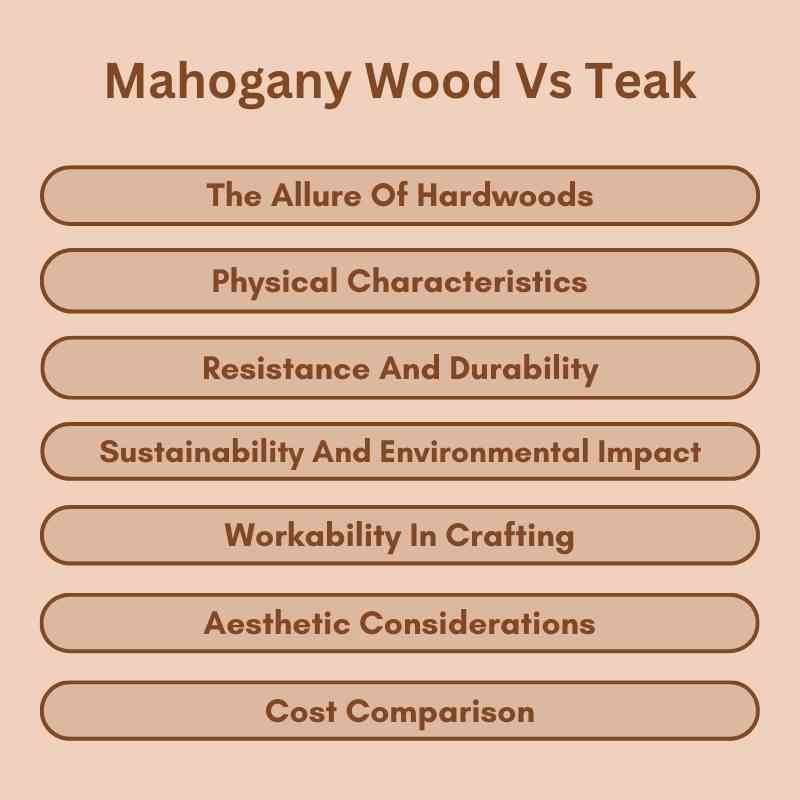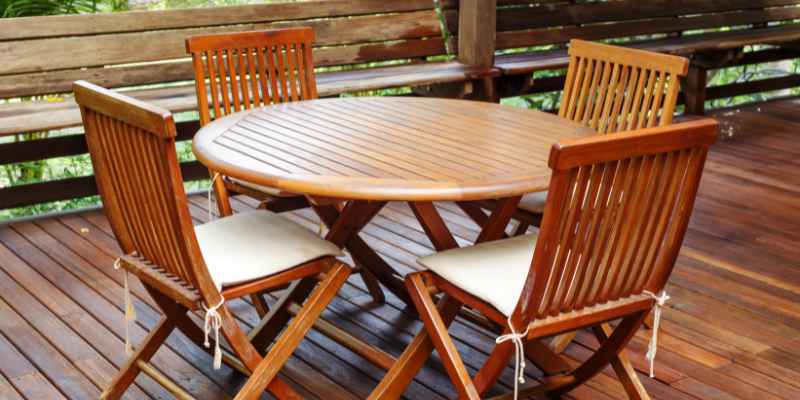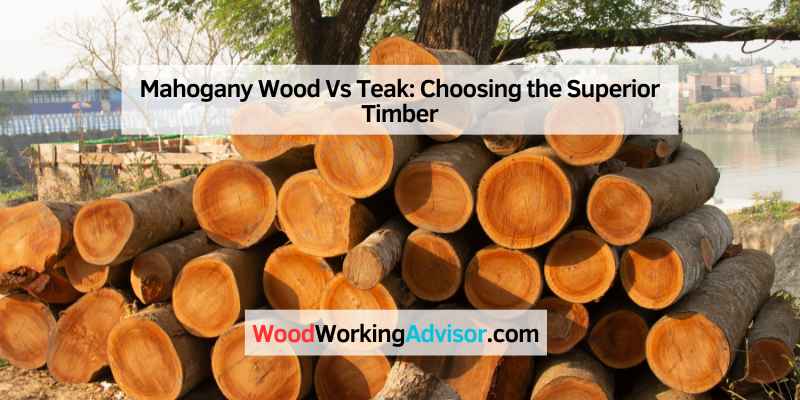Mahogany wood is known for its rich color and durability, while teak offers superior weather resistance and strength. Both woods serve different purposes and preferences in furniture and design.
Choosing the right wood can significantly impact your project. Mahogany, with its deep reddish-brown hue, is often favored for its elegance and fine grain. It’s commonly used in high-end furniture and cabinetry. Teak, on the other hand, boasts natural oils that make it resistant to moisture and pests, perfect for outdoor furniture.
The choice between these two woods depends on your specific needs, aesthetic preferences, and intended use. Understanding their unique properties helps in making an informed decision for your woodworking projects or home decor.
The Allure Of Hardwoods
Hardwoods captivate with their beauty and strength. Two of the most sought-after hardwoods are Mahogany and Teak. Both bring unique qualities to furniture and flooring. Understanding their charm helps in making the best choice.
Mahogany’s Rich History
Mahogany has a storied past. It originates from the Caribbean and Central America. This wood was prized by explorers and shipbuilders. Its deep reddish-brown hue adds warmth to any space.
- Used in high-end furniture since the 18th century.
- Known for its durability and resistance to warping.
- Features a fine, straight grain that enhances its beauty.
Its history is not just about looks. Mahogany symbolizes luxury and elegance. Many classic pieces of furniture showcase this wood’s charm.
Teak’s Timeless Appeal
Teak is famous for its strength and weather resistance. Native to Southeast Asia, it thrives in tropical climates. This wood has been used for centuries in shipbuilding.
| Feature | Mahogany | Teak |
|---|---|---|
| Color | Deep reddish-brown | Golden-brown to dark brown |
| Durability | Moderate | High |
| Resistance to Water | Low | High |
Teak requires little maintenance. It naturally resists pests and moisture. This wood’s unique oils protect it from the elements.
- Ideal for outdoor furniture.
- Age gracefully with a silver patina.
- High demand due to its lasting quality.
Physical Characteristics

Resistance And Durability
Choosing the right wood involves understanding its resistance and durability. Mahogany and teak are both strong options. Each wood offers unique benefits against decay, pests, and weather conditions. Let’s explore how these two woods stand up against challenges.
Combatting Decay And Pests
Both mahogany and teak resist decay and pests effectively. Here’s a quick comparison:
| Feature | Mahogany | Teak |
|---|---|---|
| Natural Oils | Moderate | High |
| Resistance to Termites | Good | Excellent |
| Decay Resistance | Good | Excellent |
Teak has natural oils that protect it from decay. Mahogany offers decent protection but not as strong as teak. Termites rarely damage teak, making it a better choice for outdoor items.
Withstanding Weather And Time
Weather can wear down wood quickly. Mahogany and teak handle it differently:
- Mahogany:
- Can warp or crack in extreme weather.
- Needs regular maintenance for longevity.
- Teak:
- Holds up well in sun and rain.
- Develops a beautiful patina over time.
Teak excels in harsh conditions. It remains stable and durable. Mahogany requires careful care to maintain its beauty and strength. Choose teak for outdoor furniture and mahogany for indoor designs.
Sustainability And Environmental Impact
Choosing between Mahogany and Teak involves understanding their sustainability. Both woods have unique harvesting methods that impact the environment. Sustainable practices ensure that forests remain healthy and vibrant.
Harvesting Practices
Mahogany and Teak have different harvesting practices. Responsible sourcing is crucial for both types of wood. Here’s a quick comparison:
| Wood Type | Harvesting Method | Sustainability Level |
|---|---|---|
| Mahogany | Selective logging | Moderate |
| Teak | Plantation grown | High |
Selective logging for mahogany can lead to forest degradation. Responsible companies use certified sources to help. Teak is often grown in plantations, which promotes sustainable forestry. This method reduces deforestation.
Eco-friendly Alternatives
Many eco-friendly alternatives exist for both woods. Here are some options:
- Bamboo: Grows fast and is highly renewable.
- Cork: Harvested without harming trees.
- Reclaimed Wood: Reduces waste and promotes recycling.
Choosing these alternatives supports sustainability. They help reduce the demand for mahogany and teak. This choice can preserve forests for future generations.
Workability In Crafting
Choosing the right wood for crafting is crucial. Mahogany and teak both offer unique qualities. Understanding their workability can help you make the best choice.
Ease Of Cutting And Shaping
Mahogany wood is known for its excellent workability. It cuts easily and shapes well. Carpenters love its smooth texture.
- Mahogany is soft and easy to carve.
- It holds intricate details well.
- Very few tools are needed for shaping.
Teak wood is also workable but requires more effort. It is dense and harder than mahogany. This affects how it is shaped.
- Teak needs sharp tools for cutting.
- It may splinter if not handled carefully.
- Best suited for strong, durable pieces.
Finishing And Treatment
Finishing mahogany is straightforward. It absorbs stains and finishes evenly. The result is a beautiful, rich color.
| Finishing Type | Mahogany | Teak |
|---|---|---|
| Staining | Absorbs well | May require special oils |
| Sealing | Easy to seal | Natural oils resist sealing |
| Polishing | Gives a smooth finish | Requires more effort |
Teak has natural oils that resist moisture. This makes it ideal for outdoor furniture. However, it can be more challenging to finish.
- Teak may require oil treatments regularly.
- Choosing the right finish is essential for durability.
Aesthetic Considerations
Choosing between Mahogany and Teak involves more than just durability. Aesthetics play a crucial role. Both woods have unique beauty that enhances furniture and decor.
Furniture And Decor Trends
Mahogany offers a rich, warm look. It suits traditional and classic styles. It often appears in:
- Cabinets
- Dining tables
- Antique furniture
Teak, on the other hand, is modern and versatile. Its straight grain looks great in:
- Contemporary furniture
- Outdoor settings
- Minimalist designs
Color Changes Over Time
Both woods change color as they age. Mahogany darkens beautifully, gaining depth. It develops a rich patina over time. This makes it look even more luxurious.
Teak also undergoes color changes. It starts as a golden brown. With exposure to sunlight, it turns to a silvery gray. This change adds character to its appearance.
| Wood Type | Initial Color | Color Change |
|---|---|---|
| Mahogany | Dark reddish-brown | Darkens over time |
| Teak | Golden brown | Turns silvery gray |
Cost Comparison
Understanding the cost of Mahogany and Teak is essential. Buyers must consider both initial prices and long-term value. Below is a detailed analysis.
Market Demand And Price
Market demand affects the price of both woods. Here’s a quick overview:
| Wood Type | Current Market Price (per board foot) | Market Demand |
|---|---|---|
| Mahogany | $10 – $15 | High |
| Teak | $20 – $30 | Very High |
Teak is generally more expensive than Mahogany. This is due to higher demand and limited supply. Both woods are sought after for furniture and flooring.
Long-term Value
Long-term value is crucial in choosing between Mahogany and Teak. Here’s how they compare:
- Durability: Teak lasts longer due to its natural oils.
- Maintenance: Mahogany requires more upkeep.
- Resale Value: Teak often has a higher resale value.
- Appearance: Both have beautiful finishes that age well.
Investing in Teak may cost more upfront. It usually pays off over time. Mahogany is a more budget-friendly option but may need more care.
Making The Right Choice
Choosing between Mahogany and Teak wood can be tough. Each type has unique qualities. Understanding their differences helps you make a better decision. Consider your specific needs and preferences.
Application Suitability
Both Mahogany and Teak have unique applications. Here’s a quick comparison:
| Feature | Mahogany | Teak |
|---|---|---|
| Durability | Moderate | High |
| Moisture Resistance | Low | High |
| Best Use | Furniture, cabinetry | Outdoor furniture, boats |
Teak is ideal for outdoor items. It withstands weather and moisture. Mahogany works well for indoor furniture. It offers warmth and beauty.
Personal Preferences And Uses
Your personal taste matters. Consider these factors:
- Color: Mahogany has a rich, reddish-brown hue.
- Grain: Teak has a straight, coarse grain.
- Cost: Mahogany is often less expensive.
- Maintenance: Teak requires less upkeep.
Think about how you plan to use the wood. Is it for furniture? Or perhaps for outdoor projects? Choose the type that fits your lifestyle.
Maintenance And Care
Proper maintenance ensures the longevity and beauty of both Mahogany and Teak wood. Each type has its own care requirements, making it essential to understand how to maintain them effectively.
Cleaning And Preservation
Regular cleaning helps keep wood surfaces looking fresh. Here are some tips for both types:
| Wood Type | Cleaning Method | Preservation Tips |
|---|---|---|
| Mahogany |
|
|
| Teak |
|
|
Repair And Restoration
Both Mahogany and Teak may require repairs over time. Understanding repair methods helps maintain their beauty.
- Assess Damage: Check for scratches or dents.
- Clean the Area: Remove dust and dirt.
- Use Wood Filler: Fill in scratches or holes.
- Sand the Surface: Smooth out the repaired area.
- Refinish: Apply varnish or oil to restore shine.
Regular maintenance keeps your Mahogany and Teak wood looking beautiful for years. Follow these tips to enjoy their natural charm.
The Verdict
Choosing between Mahogany and Teak is tough. Both woods have unique features. Understanding their pros and cons helps in making the right choice.
Pros And Cons Summary
| Type | Pros | Cons |
|---|---|---|
| Mahogany |
|
|
| Teak |
|
|
Expert Recommendations
Experts suggest the following:
- Choose Mahogany for indoor furniture.
- Opt for Teak for outdoor settings.
- Consider your budget before deciding.
- Look at the wood grain. Each type has a unique look.
- Think about maintenance. Teak requires more care.
Both woods serve different purposes. Select based on your needs.

Frequently Asked Questions
What Is The Difference Between Mahogany And Teak?
Mahogany and teak are both premium hardwoods. Mahogany is known for its rich, reddish-brown color, while teak has a golden-brown hue. Teak is more water-resistant, making it ideal for outdoor furniture. Mahogany is often used for cabinetry and fine furniture due to its smooth grain and durability.
Which Wood Is More Expensive: Mahogany Or Teak?
Teak is generally more expensive than mahogany. This is due to its rarity and high demand for outdoor use. Mahogany is still a premium wood but is more accessible. The price can vary based on quality, sourcing, and market conditions, but teak usually commands a higher price.
Which Wood Is Better For Outdoor Furniture?
Teak is better for outdoor furniture due to its natural oils. These oils help resist moisture, insects, and decay. Mahogany can be used outdoors but requires more maintenance. If durability and weather resistance are priorities, teak is the preferred choice for outdoor settings.
How Do Mahogany And Teak Compare In Durability?
Both mahogany and teak are durable hardwoods, but teak outlasts mahogany in outdoor conditions. Teak’s natural oils provide additional protection against elements. Mahogany is still sturdy but may require more care and maintenance over time. For long-lasting furniture, teak is the superior option.
Conclusion
Choosing between mahogany and teak depends on your specific needs. Both woods offer unique beauty and durability. Mahogany is great for rich color and warmth, while teak excels in weather resistance. Consider your project requirements and personal style. Make an informed decision to enhance your space with the perfect wood choice.

